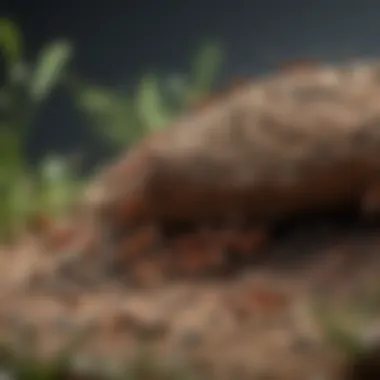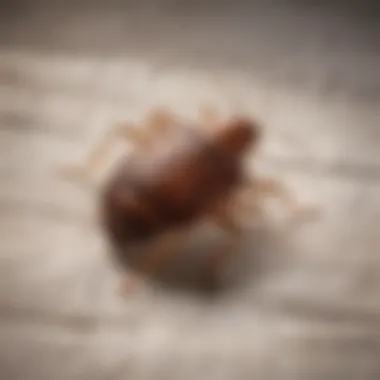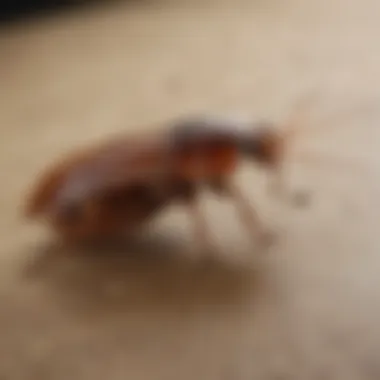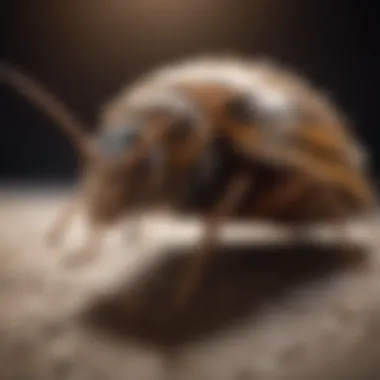Common Household Bugs in Georgia: Identification & Management


Intro
In Georgia, the warm and humid climate provides a suitable habitat for numerous pests. Homeowners and residents often encounter an array of household bugs, which can cause discomfort and in some cases, property damage. Recognizing these pests and understanding their habits are essential steps in effective management. This article will delve into the most common household bugs found in Georgia, allowing you to take informed actions to keep your home pest-free.
Identification of Common Pests
Description of Common Pests
Several bugs are typical to Georgia homes. Among these, ants are one of the most frequently seen. Species like the Argentine ant and the fire ant can invade kitchens and backyards, searching for food. Cockroaches are another prevalent pest. The American cockroach, often found in basements or attics, thrives in damp areas. Another notable pest is the bed bug, which is particularly troublesome due to its ability to hide in bedding and furniture, making detection more complex.
Other common pests include termites, which are notorious for damaging wooden structures, and spiders, which can vary in size and appearance. Each of these insects has different behaviors and characteristics that require unique identification methods.
Signs of Infestation
Detecting signs of infestations early is critical. For ants, look for trails of tiny insects leading to food sources. Cockroaches often leave droppings that resemble pepper or coffee grounds. Bed bugs typically announce their presence through small, red bite marks on the skin, along with the shed skins they leave behind.
Termites may cause noticeable damage to wood, such as hollowed-out sections; additionally, they may leave mud tubes along walls. Spiders, on the other hand, often leave webs in corners and hidden spaces, indicating their presence.
Important: Ignoring these signs can lead to larger infestations and greater challenges in control, resulting in increased costs and efforts needed for management.
Prevention Techniques
Home Maintenance Tips
Preventative measures are vital in managing household pests effectively. Regular cleaning reduces food sources for insects. Seal cracks in walls and around windows to limit entry points. Also, ensure your home has proper drainage to avoid dampness, as many pests prefer moist environments.
Environmental Modifications
Consider outdoor adjustments as well. Trim shrubs and tree branches near the home. Remove debris and standing water where pests might breed. Using mulch sparingly around plants can also deter certain insects. Create a clear zone of space between your home and any dense vegetation that might attract bugs.
Eco-Friendly Pest Control Options
Natural Pesticides
If you are looking for eco-friendly pest control options, natural pesticides can be effective. Products containing diatomaceous earth may harm insects like ants and cockroaches without dangerous chemicals. Essential oils, such as peppermint or tea tree oil, can also be effective as repellents.
Organic Pest Control Techniques
In addition to natural pesticides, some organic methods can be employed. Creating barriers using a mix of soap and water can ward off soft-bodied insects. Introducing beneficial insects, such as ladybugs, can help keep pest populations in check naturally. Being mindful of the plants you cultivate can prevent attracting undesirable bugs as well.
Prelims to Common Household Bugs
Understanding the diversity of pests that can invade your home is essential for effective management and prevention. This introduction aims to shed light on common household bugs found in Georgia, the identification of these pests, and the strategies for controlling them. As homeowners or housewives, recognizing these bugs not only helps maintain a clean environment but also prevents potential damage to properties and promotes health and safety.
Understanding the Importance of Pest Management
Pest management is vital for several reasons. First, household insects can cause significant damage to appliances, wooden structures, and furnishings. For example, termites can erode the foundation of a home, leading to expensive repairs. Second, various pests can pose health risks. Bed bugs, fleas, and cockroaches are known carriers of diseases and allergens, impacting the well-being of families, especially children and the elderly.
Adopting effective pest management techniques provides several benefits:
- Cost-effectiveness: Rather than dealing with pest infestations after they occur, preventive measures can save money in the long run.
- Enhanced comfort: A pest-free home enhances the quality of life. No one wants to share their living space with unwanted critters.
- Environmental responsibility: Many modern pest control methods focus on minimizing ecological impact, which aligns with responsible homeowners' values.
The Role of Climate in Pest Distribution
Georgia's climate plays a significant role in determining which household bugs are prevalent in the region. The warm temperatures and humid conditions provide an ideal breeding ground for various insects. Ants, cockroaches, and mosquitoes thrive in such environments, often leading to increased encounters within households. Knowing how climate influences pest distribution can guide homeowners in adopting seasonal pest prevention tactics.
For instance, during hot, humid summers, the proliferation of pests becomes more likely. Understanding this seasonal pattern allows for proactive measures like sealing cracks and ensuring proper sanitation practices during peak bug activity months. Moreover, homeowners should consider specific pest lifecycles, which may vary depending on climate conditions, to implement timely control strategies.
"Effective pest management hinges on understanding the environment and the pests within it. Awareness is key to a lasting solution."
In summary, acknowledging the significance of pest management and the climatic influences on insect populations equips homeowners with the knowledge to effectively combat infestations. This understanding lays the groundwork for exploring specific household bugs commonly found in Georgia and their management.
Common Household Bugs Found in Georgia
Households in Georgia frequently encounter various types of bugs. Understanding these common pests plays a significant role in pest management and overall home maintenance. These bugs pose different levels of risks, from health threats to structural damage. Identifying them helps in devising strategies for control and prevention. When homeowners know what they are dealing with, they can take the necessary steps to create healthier living conditions.
Ants
Identification
Ants are social insects easily recognized by their segmented bodies and elbowed antennae. They come in various colors, including black, brown, and red. Carpenter ants are particularly concerning due to their nesting habits in wood, which can weaken structures over time. Identifying their presence requires looking for trails leading to food sources and noticing small piles of sawdust around breached wood.


Behavior
Ants are known for their organized social structure. They live in colonies, which can number in thousands. Most ants are scavengers and will seek food in kitchens and pantries. Understanding their behavior helps in preventing infestations. It is important to be aware that ants communicate through pheromones to alert others about food locations.
Control Methods
Controlling ant invasions involves several methods. First, it's essential to locate their nest. Bait traps can lure ants, leading them back to the colony, thereby eliminating more ants over time. Additionally, sealing entry points reduces the chances of a future infestation.
Cockroaches
Species Identification
Cockroaches are one of the most resilient pests found in households. Key species include the American cockroach and the German cockroach. Each species has distinct features. For instance, American cockroaches are large and reddish-brown, while German cockroaches are smaller and light brown. Proper identification is crucial as it affects management strategies.
Habitat Preferences
Cockroaches thrive in warm, moist environments. They favor areas like kitchens and bathrooms where food and water are easily accessible. Understanding their habitat preferences is vital for effective pest control, as eliminating these conditions can deter future infestations.
Management Strategies
To manage cockroach problems, various strategies can be employed. Maintaining cleanliness is essential. Regularly sealing food containers and clearing crumbs can prevent food sources. Additionally, using a combination of traps and insecticides can effectively reduce their presence.
Bed Bugs
Signs of Infestation
Bed bugs are notorious for their ability to hide and reproduce rapidly. Common signs include rust-colored stains on bedding, shed skins, and bites on the skin. Awareness of these signs enables early detection, which is crucial for effective treatment.
Treatment Options
Treatment for bed bugs generally includes a combination of chemical and non-chemical methods. High heat can eliminate them, as it kills bugs at all life stages. However, chemical pesticides can be effective too, when used correctly. Expert advice may be necessary to ensure comprehensive treatment.
Preventive Measures
Preventing bed bug infestations requires proactive steps. Regularly inspecting second-hand furniture is important, as bed bugs can latch onto these items. Additionally, travel precautions, such as checking hotel rooms, can also minimize risk.
Termites
Types of Termites
In Georgia, the two most common types of termites are subterranean and drywood termites. Subterranean termites live underground and often invade houses from below. Drywood termites, on the other hand, nest inside wood and do not require contact with the soil. Knowing the type of termite can help in determining the best treatment.
Damage Indicators
Termites can cause significant damage to wooden structures if left unchecked. Common damage indicators include hollow-sounding wood and visible tunnels in wood. Homeowners should be vigilant and inspect for these signs to prevent costly repairs.
Effective Treatments
Treating termite infestations often requires professional help. Liquid barrier treatments and baiting systems are widely used. Homeowners should consider routine inspections by pest control professionals to detect termites before they cause severe damage.
Spiders
Common Species
Various species of spiders inhabit homes in Georgia, including the common house spider and the brown recluse. While not all spiders pose a threat, some can be venomous. Identifying spider types can help in understanding any potential risks they present.
Behavioral Patterns
Most spiders are solitary and seek out dark, undisturbed areas. This behavior often leads them to corners of basements, attics, and closets. Homeowners can reduce spider presence by minimizing clutter and sealing gaps where spiders might enter.
Safe Removal Techniques
When removing spiders, safety should be a priority. Using a glass or jar to capture and release them outdoors is the most humane. It is advisable to avoid hands-on removal, especially with potentially venomous species.
Silverfish
Characteristics
Silverfish are small, wingless insects known for their silver sheen and wriggling motion. They primarily feed on starchy materials, which makes them a nuisance in households. Their habit of eating clothing and paper items can lead to considerable damage.
Preferred Environments


Silverfish thrive in humid conditions. They often inhabit bathrooms and basements where moisture levels are high. Controlling humidity can play a significant role in reducing their presence in homes.
Control Approaches
To deal with silverfish, control measures must focus on drying out their environments. Reducing moisture around the home and sealing cracks can deter their entry. Additionally, traps designed specifically for silverfish can help monitor and reduce their populations.
Fleas
Life Cycle
Fleas undergo a complex life cycle that includes stages of egg, larva, pupa, and adult. Understanding their life cycle is vital for effective management. Each stage presents unique challenges, requiring thorough cleaning and treatment efforts.
Signs of Infestation
Recognizing flea infestations involves noticing signs like bites on pets, flea dirt, and seeing fleas themselves. These indicators can assist in early detection which is essential in managing their spread before they become a larger issue.
Management Tactics
Management of fleas usually requires both treating pets and the environment. Regular grooming of pets, combined with specialized flea treatments, can break the flea life cycle. Professional pest control may also be needed for severe infestations.
Preventive Measures for Household Bugs
Preventive measures for household bugs are essential. Early intervention can stop small pest problems from becoming major infestations. Homeowners can benefit from understanding how to keep bugs at bay. Effective prevention not only helps maintain a comfortable living space but also can save costs in pest management.
Home Maintenance Practices
Sealing Entry Points
Sealing entry points is a fundamental preventive strategy against household bugs. Many insects enter homes through tiny cracks and gaps. By sealing these entryways, you limit the access pests have to your living environment.
The key characteristic of sealing entry points is its simplicity. Homeowners can often do it themselves with minimal tools and expense. Common entry points include windows, doors, and utility openings. However, it is crucial to inspect these areas regularly for new gaps that may develop.
A unique feature is the range of materials you can use, such as caulk, weather stripping, or screens. Each option has its advantages. For example, using caulk in smaller cracks can provide a tight seal, while screens can allow ventilation without compromising safety. However, improper sealing can trap moisture, so it’s important to choose the right method.
Regular Inspections
Regular inspections are vital for identifying potential pest problems before they escalate. This practice involves checking your property at scheduled intervals to look for signs of insects. By being proactive, you can catch an infestation early.
The key characteristic of regular inspections is their routine nature. Setting a schedule helps ensure that pests are notable to establish themselves unnoticed. Inspecting areas like basements, attics, and around appliances can reveal early indicators.
The unique feature of this practice is in its thoroughness. A systematic approach can uncover signs such as droppings or nests. However, remember that regular inspections are time-consuming. They require commitment but can pay off in long-term pest control benefits.
Sanitation Habits
Sanitation habits play a critical role in preventing household bugs. Insects are often drawn to areas with food waste or clutter. Maintaining cleanliness minimizes these attractants.
A key characteristic of good sanitation is its simplicity. Regular cleaning and proper food storage can drastically reduce the likelihood of attracting pests. This includes disposing of garbage promptly and cleaning spills immediately.
The unique feature of sanitation is its broad impact. Not only does it help with pest control, but it also improves overall household hygiene. The downside is that poor sanitation can take only moments to develop, leading to a rapid increase in pest activity if neglected.
Landscaping Considerations
Landscaping considerations also affect household bug management. Your home's exterior environment plays an important role in pest activity. Adjustments in these areas can significantly influence pest presence.
Plant Selection
Plant selection is crucial in landscaping to mitigate household pest issues. Certain plants attract beneficial insects, while others may draw unwanted pests. Homeowners should choose plants wisely.
The main feature of this consideration is the ecosystem impact. Selective planting can promote biodiversity, which helps regulate pest populations naturally. For instance, you might prefer plants less attractive to bugs rather than those that invite them.
The unique aspect of this approach is the potential for a self-sustaining garden. However, it requires careful research. Choosing the wrong plants can enhance pest problems instead of reducing them.
Mulching Techniques
Mulching techniques can also support pest prevention in landscaping. Mulch provides several benefits, such as moisture retention and weed control. However, it can also influence pest populations.
The key characteristic of using mulch is its effectiveness in creating barriers. It can suppress weeds that attract pests and reduce soil erosion. Moreover, certain types of mulch, like cedar and pine, may have natural repellent properties to insects.
A unique feature is the variety of mulch sources available. Organic mulches can enhance soil fertility, while inorganic mulches offer durability. However, excessive moisture retention can lead to mildew and attract pests if not managed correctly.
Water Management


Water management is an essential aspect of preventing pest infestations. Standing water can create breeding grounds for insects like mosquitoes. Proper management ensures that water drains well.
A key characteristic of effective water management is monitoring drainage patterns around your property. Identify areas where water collects and take action to redirect or drain excess moisture. This proactive approach limits environments conducive to pest breeding.
The unique feature is the use of landscaping to assist in managing water runoff. Strategic planting can help with absorbing excess moisture. However, improper water management can lead to soil erosion and other issues if not addressed adequately.
Eco-Friendly Pest Control Options
As awareness of environmental issues grows, eco-friendly pest control options have become increasingly important. Homeowners often seek solutions that are effective but also safe for children, pets, and the surrounding ecosystem. Eco-friendly methods minimize health risks while providing sustainable alternatives to conventional chemical treatments. By using these methods effectively, individuals can manage pest populations while also contributing to a healthier planet.
Natural Remedies
Natural remedies are a cornerstone of eco-friendly pest control. They utilize naturally occurring substances to deter or eliminate pests. Here are some popular natural remedies:
Essential Oils
Essential oils provide a powerful way to manage pests due to their repellent properties. Many oils, such as peppermint, tea tree, and lavender, are known for their ability to ward off insects without harmful effects to the environment. The key characteristic of essential oils lies in their concentrated plant extracts, which can disrupt the life cycles of pests. This makes them an attractive choice for eco-conscious homeowners.
The unique feature of essential oils is that they can be easily infused into sprays or diffusers, allowing for convenient application. While generally safe, it is important to be cautious, as some oils can irritate the skin when used improperly.
Diatomaceous Earth
Diatomaceous earth is a natural powder made from fossilized algae. Its specific aspect is its ability to dehydrate and kill insects by damaging their exoskeletons. Due to this method of action, it does not pose harm to humans or pets, making it a popular choice for families. A significant advantage of diatomaceous earth is that it can be used both indoors and outdoors, offering versatile pest management solutions. However, one should be careful to use food-grade diatomaceous earth, as other types may contain harmful additives.
Homemade Traps
Homemade traps are an effective way to manage pests while being environmentally friendly. They often use common household items to create a barrier or lure for insects. The key characteristic of homemade traps is their accessibility; anyone can make them with items around the house. This approach allows for cost-effective pest control without buying commercial traps. The unique feature of homemade traps is their ability to target specific pests, which can reduce the risk of harming beneficial insects. However, effectiveness can vary, so homeowners may need to experiment with different designs and baits.
Non-Toxic Chemical Treatments
Non-toxic chemical treatments offer another layer of eco-friendly pest control. These solutions often derive from plants or microorganisms, providing effective management without typical chemical hazards.
Botanical Insecticides
Botanical insecticides are made from naturally occurring plant materials. This aspect allows them to target specific pests while being safer alternatives to synthetic chemicals. They can be effective in managing pests like aphids, beetles, and other common nuisances. A key feature of botanical insecticides is their rapid breakdown in the environment, which minimizes long-term impacts on non-target species. However, their effectiveness can vary depending on the particular insect and life stage.
Microbial Solutions
Microbial solutions use naturally occurring microorganisms to target pests. The specific aspect is that these solutions are often harmful only to the pests they control, allowing for a safer application around humans and pets. The key characteristic of microbial solutions is that they can persist in the environment, offering prolonged protection against pest populations. The advantage of using microbial solutions is that they can also encourage a healthy ecosystem by leaving beneficial insects unharmed. However, it is essential to understand the specific strains and their application methods to maximize effectiveness.
Professional Pest Management Services
Effective pest management encompasses several strategies that ensure a pest-free environment. When common household bugs infiltrate homes, it becomes paramount to consider professional pest management services. These services offer expertise, which is often lacking in DIY approaches. Professionals are trained to identify different pests accurately, understand their behaviors, and determine the right treatment methods.
The key benefits of hiring professional pest control include comprehensive inspections, access to specialized equipment, and the ability to apply methods that adhere to safety regulations. Homeowners may not have the knowledge or tools necessary to handle infestations effectively. By opting for professional services, the risks of mishandling toxic substances or applying incorrect treatments are significantly reduced. Moreover, many pest management companies provide preventative measures to deter future infestations, offering peace of mind for homeowners.
When to Call a Professional
Determining the right time to call in pest control experts can save time and money. If infestations are severe or persistent, professional help is often essential. Some situations warrant immediate attention:
- Visible Infestation: If you see multiple insects consistently, it may indicate a larger problem.
- Damage Signs: Presence of chewed materials, droppings, or nests suggests an ongoing issue.
- Health Concerns: Pests like rodents or cockroaches can pose health risks; their elimination should be prioritized.
It is also wise to seek professional assistance if you have tried DIY methods with no success. Sometimes, certain pests require specialized treatments that only professionals can provide effectively.
Choosing the Right Pest Control Company
Selecting an appropriate pest control company involves careful consideration. Here are some factors to evaluate:
- Experience and Reputation: Research the company’s history and customer reviews to gauge their effectiveness.
- Licensing and Certification: Ensure that the company holds necessary licenses and certifications for pest management, displaying compliance with local regulations.
- Services Offered: Not all companies handle all pests. Ensure the company specializes in the specific pests you are dealing with.
- Eco-Friendly Practices: Consider companies that use environmentally responsible treatment methods, particularly if you have pets or children at home.
- Guarantees and Warranties: A reputable company should offer a satisfaction guarantee for their services, common in the industry.
By recognizing these factors, homeowners can make informed choices about pest management services and ensure their homes remain safe and pest-free.
Epilogue and Final Thoughts
In summary, understanding common household bugs in Georgia is crucial for effective pest management. Household pests can disrupt both comfort and health, making their identification and control a significant concern for homeowners. This article highlighted the various prevalent bugs, noting their distinctive traits, habits, and management strategies.
With pests such as ants, cockroaches, bed bugs, termites, spiders, silverfish, and fleas affecting homes across the state, a systematic approach is necessary. Homeowners are encouraged to actively monitor their environment and stay informed on pest behavior to catch infestations early.
Additionally, the importance of preventive measures cannot be overstated. By regularly inspecting the home, sealing entry points, and enhancing sanitation, residents can create an inhospitable environment for pests. This proactive stance not only prevents infestations but also reduces the reliance on chemical treatments, thus benefiting the ecosystem.
Moreover, the article discussed eco-friendly pest control options, ranging from natural remedies to non-toxic chemical treatments. This consideration aligns with a growing desire for sustainable practices in pest management, helping protect the environment while addressing pest issues effectively.
When faced with persistent or severe infestations, professional pest management services play a vital role. Recognizing when to seek expertise and how to choose the right company ensures that effective, targeted solutions are employed, safeguarding the home from further damage.
Ultimately, the comprehensive understanding provided about pests in Georgia underscores the need for ongoing vigilance and informed decision-making. The integration of prevention, eco-friendly practices, and professional interventions offers the best path forward for maintaining a pest-free living environment.
"Knowledge is power. Understanding your pest problems is the first step towards an effective solution."
Embracing these principles enables homeowners not just to react to issues but to cultivate a living space that is genuinely accommodating and healthy.







